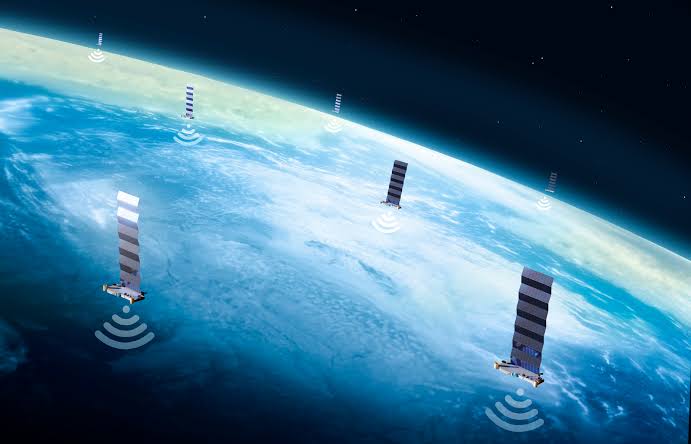The billionaire’s Starlink communications network is encountering growing competition for its leadership in high-speed satellite internet. This includes challenges from a Chinese state-supported competitor and another service backed by Amazon founder Jeff Bezos.
In November, Shanghai-based SpaceSail secured an agreement to expand into Brazil and revealed that it was in discussions with more than 30 countries. Two months later, it commenced operations in Kazakhstan, as reported by the Kazakh embassy in Beijing.
Brasília is currently engaged in discussions with Project Kuiper, the internet service developed by Jeff Bezos, as well as Canada’s Telesat, according to a Brazilian official who requested anonymity to speak candidly about the ongoing negotiations. This information is being reported for the first time.
Since 2020, Starlink has deployed more satellites into low-Earth orbit (LEO)—defined as an altitude of less than 2,000 km—than all of its competitors combined. Satellites positioned at these low altitudes are capable of transmitting data with remarkable efficiency, thereby delivering high-speed internet access to remote communities, maritime vessels, and military operations.
Musk’s dominance in the space sector is perceived as a challenge by Beijing, which is significantly investing in competing ventures and financing military research aimed at developing technologies to monitor satellite constellations, as indicated by Chinese corporate documents and academic studies that have not been disclosed before.
Last year, China set a new record by launching 263 low Earth orbit (LEO) satellites, based on data analyzed by astrophysicist Jonathan McDowell in collaboration with the tech consultancy Analysis Mason.
The Brazilian government has expressed support for the rise of competitors to Starlink, as it seeks to provide high-speed internet access to remote communities, despite having had prior conflicts with Musk regarding business and political matters.
SpaceSail did not provide any comments in response to Reuters’ inquiries regarding its plans for expansion.
A publication overseen by China’s telecommunications authority lauded the service last year, describing it as “able to surpass national borders, infringe on sovereignty, and provide unconditional global coverage… a strategic capability that our nation must acquire.”
Read more: Ukraine: N.Korea Supply Half of Russia’s Ammo.
Kuiper, Telesat, Starlink, and Brazil’s communications ministry did not provide comments when approached. Few of Musk’s global competitors share the same level of ambition as SpaceSail, which is overseen by the Shanghai municipal government. The company has revealed intentions to launch 648 LEO satellites this year, with a potential total of 15,000 by 2030. In comparison, Starlink currently operates approximately 7,000 satellites and aims to have 42,000 in operation by the decade’s end.
SpaceSail’s future launches will ultimately make up the Qianfan, or “Thousand Sails,” constellation, representing China’s initial foray into international satellite broadband. In addition, three other satellite constellations are being developed by China, with plans to deploy 43,000 low-Earth orbit (LEO) satellites over the upcoming decades and invest in rockets capable of carrying multiple satellites. “The goal is to secure as many orbital positions as feasible,” noted Chaitanya Giri, a space technology analyst at India’s Observer Research Foundation.
Western policymakers have expressed alarm regarding China’s push to control more of lower-Earth orbit, fearing it may extend Beijing’s internet censorship policies. In a paper published in February, scholars at the American Foreign Policy Council advised that Washington should enhance its cooperation with Global South countries if it intends to “seriously challenge China’s expanding digital influence.” They also highlighted Qianfan as a vital element of the space aspect of China’s Belt and Road Initiative. This $1 trillion global infrastructure program is a hallmark of Chinese leader Xi Jinping’s governance but has faced criticism for allegedly serving mainly as a mechanism for amplifying Beijing’s geopolitical power.
Neither China’s commerce ministry nor its telecommunications regulator responded to requests for comment. The foreign ministry, addressing inquiries from Reuters, stated that while it was not familiar with specific details about SpaceSail and China’s overseas expansion of LEO satellites, Beijing seeks space partnerships with other nations for mutual benefit. SpaceSail claims its mission is to provide reliable internet access to a greater number of individuals, particularly those in isolated regions and those affected by emergencies and natural disasters.
Starlink’s swift growth and its deployment in the Ukraine conflict have drawn interest from military researchers, including those at China’s National University of Defense Technology, leading to substantial government funding for competing satellite networks. Hongqing Technology, established in 2017 and working on a constellation of 10,000 satellites, recently secured 340 million yuan from largely state-associated investors. Last year, SpaceSail raised 6.7 billion yuan ($930 million) in a funding round led by a state-owned investment firm focused on enhancing China’s manufacturing capabilities.
Chinese researchers, many of whom are connected to the People’s Liberation Army, are increasingly focusing on this sector. According to the AcclaimIP database from Anaqua, China issued a record 2,449 patents related to LEO satellite technology in 2023, a significant increase from 162 in 2019. Many of these patents are concentrated on creating cost-effective satellite networks and low-latency communication systems, emphasizing China’s effort to bridge the technology gap. “The space arena is rapidly evolving and experimenting,” stated Antoine Grenier, the global head of space at Analysys Mason consultancy. “Innovators are taking advantage of this relative freedom to secure crucial positions ahead of more stringent regulations – akin to the wild west.”
Certain Chinese research seems aimed at countering Starlink, with one patent application linked to the PLA describing the U.S. system as vital for reconnaissance and military communications while presenting “threats to network, data, and military security.” Additionally, Beijing is working on methods to monitor and track Starlink’s constellation. A January study published in a Chinese engineering journal, authored by researchers from two institutes linked to the PLA, outlined a system and an algorithm designed to track megaconstellations like Starlink’s, drawing inspiration from the way humpback whales capture their prey by encircling them and generating spiraling bubbles. “With the increasing trend of militarization in space, the development of tools to monitor and track these megaconstellations is of paramount importance,” the researchers expressed.




